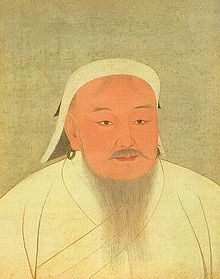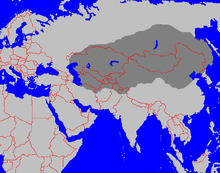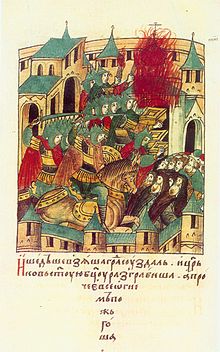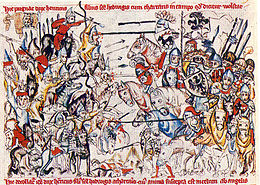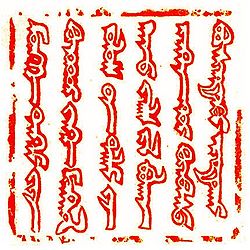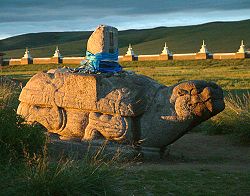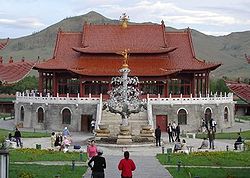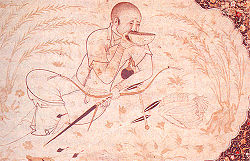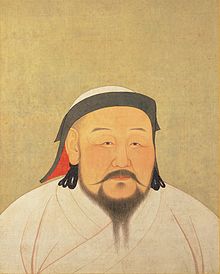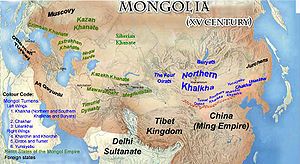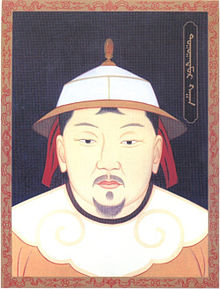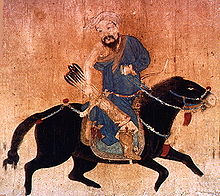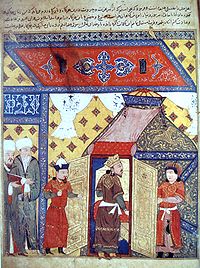- Mongol Empire
-
Mongol Empire
Ikh Mongol Uls← 
1206–1368 ↓ Modern reconstruction of the Nine Base White Banners
Capital Avarga
Karakorum[note 1]
Dadu[note 2] (modern Beijing)Religion Tengriism (Shamanism), later Buddhism, Christianity and Islam Government Elective monarchy Great Khan - 1206-1227 Genghis Khan - 1229-1241 Ögedei Khan - 1246-1248 Güyük Khan - 1251-1259 Möngke Khan - 1260-1294 Kublai Khan - 1333–1370 Toghan Temur Khan Legislature Kurultai History - Genghis Khan unified the tribes and proclaimed the Great Mongol State 1206 - Death of Genghis Khan 1227 - Pax Mongolica 1210-1350 - Fragmentation of the empire 1260-1264 - Fall of Yuan Dynasty, marking the empire's final dissolution 1368 Currency Coins (such as dirhams), Sukhe, paper money (paper currency backed by silk or silver ingots, and the Yuan's Chao) Preceded by Succeeded by 
Khamag Mongol Chagatai Khanate 
Golden Horde 
Ilkhanate 
Yuan Dynasty 
Northern Yuan 
Today part of The Mongol Empire (Mongolian:
 listen (help·info) Mongol-yn Ezent Güren; Cyrillic: Монголын эзэнт гүрэн), initially named as Greater Mongol State (Mongolian: Ikh Mongol Uls) was a great empire during the 13th and 14th centuries. Beginning in the Central Asian steppes, it eventually stretched from Eastern Europe to the Sea of Japan, covered large parts of Siberia in the north and extended southward into Southeast Asia, the Indian subcontinent, and the Middle East. It is commonly referred to as the largest contiguous empire in the history of the world. At its greatest extent it spanned 9,700 km (6,000 mi), covered an area of 24,000,000 km2 (9,300,000 sq mi),[1][2][3][4] 16% of the Earth's total land area, and held sway over a population of 100 million.
listen (help·info) Mongol-yn Ezent Güren; Cyrillic: Монголын эзэнт гүрэн), initially named as Greater Mongol State (Mongolian: Ikh Mongol Uls) was a great empire during the 13th and 14th centuries. Beginning in the Central Asian steppes, it eventually stretched from Eastern Europe to the Sea of Japan, covered large parts of Siberia in the north and extended southward into Southeast Asia, the Indian subcontinent, and the Middle East. It is commonly referred to as the largest contiguous empire in the history of the world. At its greatest extent it spanned 9,700 km (6,000 mi), covered an area of 24,000,000 km2 (9,300,000 sq mi),[1][2][3][4] 16% of the Earth's total land area, and held sway over a population of 100 million.The Mongol Empire emerged from the unification of Mongol and Turkic tribes in the region of modern-day Mongolia under the leadership of Genghis Khan, who was proclaimed ruler of all Mongols in 1206. The Empire grew rapidly under his leadership and then that of his descendants, who sent invasions in every direction.[5][6][7][8][9][10] The vast transcontinental empire which connected the east with the west would eventually function as a cultural "clearing house" for the Old World. Under the Mongols, new technologies, various commodities and ideologies were disseminated and exchanged across Eurasia; the exchanges ranged from cartography to printing, from agriculture to astronomy.[11][12]
The Empire began to split as a result of wars over succession, as the grandchildren of Genghis Khan disputed whether the royal line should follow from Genghis's son and initial heir Ogedei, or one of his other sons such as Tolui, Chagatai, or Jochi. The Toluids prevailed after a bloody purge of Ogedeid and Chagataid factions, but disputes continued even among the descendants of Tolui. Rival councils would simultaneously elect different Great Khans, such as when brothers Ariqboke and Kublai were both elected and then not only had to defy each other, but also deal with challenges from descendants of other of Genghis's sons. Genghis's descendants would either challenge the decision of Great Khan, or assert independence in their own section of the Empire.[13][14]
Kublai successfully took power, but civil war ensued, as Kublai sought, unsuccessfully, to regain control of the Chagatayid and Ogedeid families. By the time of Kublai's death, the Mongol Empire had fractured into four separate khanates or empires, each pursuing its own separate interests and objectives: the Golden Horde khanate in the northwest, the Chagatai Khanate in the west, the Ilkhanate in the southwest, and the Yuan Dynasty based in modern-day Beijing.[15]
It was not until the early 14th century, when the three western khanates accepted the nominal suzerainty of the Yuan Dynasty, that the Mongol world again acknowledged a single paramount suzerain for the first time since 1259 - even though the supremacy of the Yuan emperors over the western khanates was by and large symbolic.[16][17] When the Yuan Dynasty was overthrown by the Han Chinese Ming Dynasty under Zhu Yuanzhang in 1368, the Mongol Empire finally dissolved.
Contents
Name
What is referred to in English as the Mongol Empire is described in the modern Mongolian language as "Mongolyn Ezent Guren" (Монголын эзэнт гүрэн) and as "Ikh Mongol Uls" (Их Монгол улс), "Greater Mongol State".[citation needed] Genghis Khan used the latter when he was proclaimed Emperor. In the 1240s, Genghis's descendant Güyük Khan wrote a letter to Pope Innocent IV which used the preamble, "Dalai Khagan of the great Mongol state (ulus)".[18]
After the succession war between Kublai Khan and his brother Ariq Böke which limited his real power to the east, Kublai Khan officially issued an imperial edict on December 17, 1271 to name the country "Great Yuan" (Dai Yuan, or Dai On Ulus) to establish the Yuan Dynasty, though some sources state that the full Mongolian name was "Dai Ön Yehe Monggul Ulus".[19]
History
Pre-Empire context
Main article: Mongols before Genghis KhanThe area around Mongolia, Manchuria, and parts of North China had been controlled by the Liao Dynasty since the 10th century. In 1125, the Jin Dynasty founded by the Jurchens overthrew the Liao Dynasty, and attempted to gain control over former Liao territory in Mongolia. The Jin Dynasty rulers, known as the Golden Kings, were resisted by the Khamag Mongol confederation, which was ruled by Khabul Khan, great grandfather of Temujin (Genghis Khan). Khabul Khan pushed out the forces of the Jin Dynasty from Mongol territory in the 1130s. There were five main powerful tribal confederation (khanlig) in the Mongolian plateau at the time: Kereit, Khamag Mongol, Naiman, Mergid and Tatar. The Jin emperors encouraged the Tatars in their dispute with the Mongols, in order to keep the nomadic tribes distracted by their own battles, and thereby away from the Jin. The Tatars betrayed Ambaghai Khan, successor of Khabul, to the Jurchen who executed him. The Mongols retaliated by raiding the frontier and the Jurchen counter-attack failed in 1143. In 1147 the Jin signed a peace treaty with the Mongols and withdrew a score of forts that threatened them; this devised a more subtle indirect policy against the nomads. After that the Mongols attacked the Tatars to avenge the death of their late khan, opening a long period of active hostilities. The Jin and Tatar armies defeated the Mongols in 1161. These events well illustrate the Jin policy of divide and rule.[20]
Genghis Khan
History of the Mongols 
Before Genghis Khan Khamag Mongol Mongol Empire Khanates - Chagatai Khanate - Golden Horde - Ilkhanate - Yuan Dynasty Northern Yuan Timurid Empire Mughal Empire Crimean Khanate Khanate of Sibir Zunghar Khanate Mongolia during Qing Outer Mongolia (1911-1919) Republic of China (Occupation of Mongolia) Mongolian People's Republic (Outer Mongolia) Modern Mongolia Mengjiang (Inner Mongolia) People's Republic of China (Inner Mongolia) Republic of Buryatia Kalmyk Republic Hazara Mongols Aimak Mongols Timeline edit box Main articles: Khamag Mongol and Genghis Khan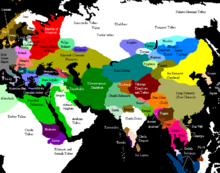 Eurasia on the eve of the Mongol invasions, c. 1200.
Eurasia on the eve of the Mongol invasions, c. 1200.
Known during his childhood as Temujin, Genghis Khan was the son of a Mongol chieftain. He suffered a difficult childhood, and when his young wife Borte was kidnapped by a rival tribe, Temujin united the nomadic, previously ever-rivaling Mongol–Turkic tribes under his rule through political manipulation and military might. His most powerful allies were his father's friend, Kereyd chieftain Wang Khan Toghoril, and Temujin's childhood anda (blood brother) Jamukha of the Jadran clan. With their help, Temujin defeated the Merkit tribe, rescued his wife Borte, and then went on to defeat the Naimans and Tatars.[21]
Temujin forbade looting and raping of his enemies without permission, and he divided the spoils to Mongol warriors and their families instead of giving all to the aristocrats.[22] He thus held the title Khan. However, his uncles were also legitimate heirs to the throne, and this decision brought conflict among his generals and associates. His previous ally Jamukha of the Jadran clan, as well as the Kereyds, separated from Temujin. For rival aristocrats, Temujin was regarded not as leader but merely an insolent usurper. Temujin's powerful position and reputation among other Mongols and nomads raised the fears of Kereyd nobles. Virtually all his uncles, cousins and other clan chieftains turned against him, and war ensued. Temujin's forces were nearly defeated, but he recovered and was reinforced by tribes loyal to him. In 1203-1205, the Mongols under Temujin destroyed all the remaining rival tribes and brought them under his sway. In 1206, Temujin was crowned as the Khaghan of the Yekhe Mongol Ulus (Great Mongol Nation) at a Huruldai (general assembly/council). It was there that he assumed the title of "Genghis Khan" instead of the old tribal titles such as Gur Khan or Tayang Khan. This event essentially marked the start of the Mongol Empire under the leadership of Genghis Khan.[21]
Early organization
Genghis Khan innovated many ways of organizing his army, dividing it into decimal subsections of arbans (10 people), zuuns (100), myangans (1000) and tumens (10,000). The Kheshig or the Imperial Guard was founded and divided into day (khorchin, torghuds) and night guards (khevtuul).[23] He rewarded those who had been loyal to him and placed them in high positions, placing them as heads of army units and households, even though many of his allies had been from very low-rank clans. Compared to the units he gave to his loyal companions, those assigned to his own family members were quite few. He proclaimed a new law of the Empire, Ikh Zasag or Yassa, and codified everything related to the everyday life and political affairs of the nomads at the time. He forbade the selling of women, theft of other's properties, fighting between the Mongols, and the hunting of animals during the breeding season.[24]
He appointed his adopted brother Shigi-Khuthugh supreme judge (jarughachi), ordering him to keep records of the Empire. In addition to laws regarding family, food and army, Genghis also decreed religious freedom and supported domestic and international trade. He exempted the poor and the clergy from taxation.[25] Thus, Muslims, Buddhists and Christians from Manchuria, North China, India and Persia joined Genghis Khan long before his foreign conquests. The Khan also encouraged literacy, adopting the Uyghur script which would form the Uyghur-Mongolian script of the Empire, and he ordered the Uyghur Tatatunga, who had previously served the khan of Naimans, to instruct his sons.[26]
Genghis quickly came into conflict with the Jin Dynasty of the Jurchens and the Western Xia of the Tanguts in northern China. Towards the West, under the provocation of the Muslim Khwarezmid Empire, he moved into Central Asia as well, devastating Transoxiana and eastern Persia, then raiding into Kievan Rus' (a predecessor state of Russia, Belarus and Ukraine) and the Caucasus.[21]
Before his death, Genghis Khan divided his Empire among his sons and immediate family. But as custom made clear, the Mongol Empire remained the joint property of the entire imperial family who, along with the Mongol aristocracy, constituted the ruling class.[27]
Expansion under Ogedei
Main article: Mongol conquestsThe Mongol Empire started in Central Asia, with the unification of Mongol and Turkic tribes. Under the leadership of Genghis Khan, the Empire expanded westwards across Asia into the Middle East, Rus, and Europe; southward into India and China; and eastward as far as the Korean peninsula, and into Southeast Asia.[21]
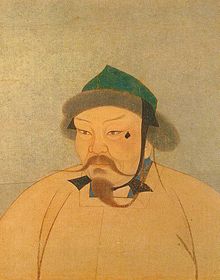 Ögedei Khan, Genghis Khan's son and successor.
Ögedei Khan, Genghis Khan's son and successor.
Genghis Khan died in 1227, by which point the Mongol Empire ruled from the Pacific Ocean to the Caspian Sea – an empire twice the size of the Roman Empire and Muslim Caliphate. Genghis had directed that his heir should be his third son, the charismatic Ogedei. The regency was originally held by Ogedei's younger brother Tolui, until Ogedei's formal election at the kuriltai in 1229.[28]
Among his first actions, Ogedei sent troops to subjugate the Bashkirs, Bulgars, and other nations in the Kipchak controlled steppes, eventually allying with the Bashkirs.[29] In the east, Ogedei's armies re-established Mongol authority in Manchuria, crushing the Eastern Xia regime and Water Tatars. In 1230, the Great Khan personally led his army in the campaign against the Jin Dynasty (China). Ogedei's general Subotai captured Emperor Wanyan Shouxu's capital, Kaifeng in 1232.[30] In 1234, three armies commanded by Ogedei's sons Kochu and Koten, as well as the Tangut general Chagan, invaded southern China. With the assistance of the Song Dynasty, the Mongols finished off the Jin in 1234.[31][32] In the West, Ogedei's general Chormaqan destroyed Jalal ud-Din Menguberdi, the last shah of the Khwarizmian Empire. The small kingdoms in Southern Persia voluntarily accepted Mongol supremacy.[33][34] In East Asia, there were Mongol victories upon Korean armies, but Ogedei's attempt to annex the Korean peninsula met with less success. The king of Goryeo surrendered but revolted and massacred Mongol darugachis (overseers) and pro-Mongol Koreans.[29]
While Ogedei finished the construction of a new capital Karakorum in 1235-1238, Mongol administrations headed by Muslims and Khitans were established in North China, Turkestan and Transoxiana. In addition to building relay stations and roads, Ogedei pacified newly conquered populations, suppressed banditry or piracy, and decreed a proportion of all sheep should be levied to the impoverished.[35][Full citation needed]
In an offensive against the Song Dynasty, Mongol armies captured Siyang-yang, the Yangtze and Sichuan, but did not secure their control. The Song generals were able to recapture Siyang-yang from the Mongols in 1239. After the sudden death of Ogedei's son Kochu in Chinese territory, the Mongols withdrew from southern China, but Kochu's brother Prince Koten invaded Tibet after their withdrawal.[21]
Another grandson of Genghis by his son Jochi, Batu Khan, overran the countries of the Bulgars, the Alans, the Kypchaks, Bashkirs, Mordvins, Chuvash, and other nations of the southern Russian steppe. By 1237, the Mongols began encroaching upon their first Russian principality, Ryazan. After a 3 day-siege using heavy bombardment, the Mongols captured the city and massacred its inhabitants, then proceeding to destroy the army of the Grand principality of Vladimir at the Sit River. The Mongols captured the Alania capital, Maghas, in 1238. By 1240, all Rus’ lands including Kiev had fallen to the Asian invaders except for a few northern cities. Mongol troops under Chormaqan in Persia connected his invasion of Transcaucasia with the invasion of Batu and Subotai, forcing the Georgian and Armenian nobles to surrender as well.[36]
But strife continued within the Mongol ranks. Despite his military victories, Batu's relations with Güyük, Ogedei's eldest son, and Büri, the beloved grandson of Chagatai Khan, remained tense, and worsened during Batu's victory banquet in southern Russia. But Guyuk and Buri could do nothing to harm Batu's position as long as his uncle Ogedei was still alive. Meanwhile, Ogedei continued with Mongol invasions into the Indian subcontinent, temporarily investing Uchch, Lahore and Multan of the Delhi Sultanate and stationing a Mongol overseer in Kashmir.[37] However, the invasions into India were defeated and driven back. Ogedei agreed to receive tributes from the court of Goryeo and reinforced his keshig with the Koreans through both diplomacy and military force.[38][39][40]
The battle of Liegnitz, 1241. From a medieval manuscript of the Hedwig legend.
The advance into Europe continued with Mongol invasions of Poland, Hungary and Transylvania. When the western flank of the Mongols plundered Polish cities, a European alliance consisting of the Poles, the Moravians, the Christian military orders of the Hospitallers, Teutonic Knights and the Templars assembled sufficient forces to halt the Mongol advance at Legnica, but only briefly. The Hungarian army, their Croatian allies and the Templar Knights were beaten by Mongols at the banks of Sajo River on April 11, 1241. After their victories over European Knights at Legnica and Muhi, Mongol armies quickly advanced across Bohemia, Serbia, Babenberg Austria and into the Holy Roman Empire.[41][42] But before Batu's forces could continue into Vienna and northern Albania, he received news of Ogedei's death in December 1241.[43][44] As was customary in Mongol military tradition, all princes of Genghis's line had to attend the kurultai to elect a successor. Batu and his western Mongol army withdrew from Central Europe the next year.[45]
Post-Ogedei power struggles
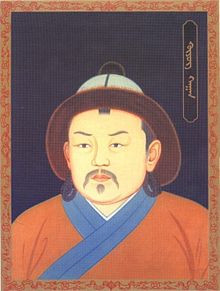 Güyük Khan, Ögedei Khan's son and successor.
Güyük Khan, Ögedei Khan's son and successor.
Following the Great Khan Ogedei's death in 1241, his widow Toregene took over the empire. She persecuted her husband's Khitan and Muslim officials, giving high positions to her own allies instead. She built palaces, cathedrals and social structures on an imperial scale, supporting religion and education. She was able to win over most Mongol aristocrats to support Ogedei's son Guyuk. But Batu, ruler of the Golden Horde, refused to come to the kurultai, claiming he was ill and the Mongolian climate was too harsh for him. The resulting stalemate lasted more than four years, and further destabilized the unity of the Empire.[46]
When Genghis Khan's youngest brother Temuge threatened Toregene to seize the throne, Guyuk came to Karakorum to try and secure his position.[47] Batu eventually agreed to send his brothers and generals to the kurultai which Toregene convened in 1246. Guyuk by this time was ill and alcoholic, but his campaigns in Manchuria and Europe gave him the kind of stature necessary for a Great Khan. He was duly elected at a ceremony attended by Mongols and foreign dignitaries from both within and without the Empire—leaders of vassal nations, and representatives from Rome and other entities, who came to the kurultai to show their respects and negotiate diplomacy.[48][49]
Guyuk took steps to reduce corruption, announcing that he would continue the policies of his father Ogedei, not Toregene. He punished Toregene's supporters, except governor Arghun the Elder. He also replaced young Khara Hulegu, the Khan of the Chagatai Khanate, with his favorite cousin Yesü Möngke to assert his newly conferred powers. He restored his father's officials to their former positions and was surrounded by the Uyghur, Naiman and Central Asian officials, favoring Han Chinese commanders who helped his father's conquest of North China. He continued military operations in Korea, advanced into Song China and Iraq, and ordered an Empire-wide census. Guyuk also divided the Sultanate of Rum between Izz-ad-Din Kaykawus and Rukn ad-Din Kilij Arslan, though Kaykawus disagreed with this decision.[50]
Not all parts of the Empire respected Guyuk's election. The Hashshashins, former Mongol allies whose Grand Master Hasan Jalalud-Din had offered his submission to Genghis Khan in 1221, angered Guyuk by refusing to submit, instead murdering Mongol generals in Persia. Guyuk appointed his best friend's father Eljigidei as chief commander of the troops in Persia, tasked with both reducing the strongholds of the Assassins, and also conquering the Abbasids in the center of the Islamic world, Iran and Iraq.[50][51][52]
In 1248, Guyuk raised more troops and suddenly marched westwards from the Mongol capital of Karakorum. The reasoning was unclear: some sources wrote that he sought to recuperate at his personal property Emyl; others suggested that he might have been moving to join Eljigidei to conduct a full-scale conquest of the Middle East, or possibly to make a surprise attack on his rival cousin Batu Khan in Russia. Suspicious of Guyuk's motives, Sorghaghtani Beki, the widow of Genghis's son Tolui, secretly warned her nephew Batu of Guyuk's approach. Batu had himself been traveling eastwards at the time, possibly to pay homage, or perhaps with other plans in mind. Before the forces of Batu and Guyuk met though, Guyuk, sick and worn out by travel, died en route at Qum-Senggir in Eastern Turkestan, possibly a victim of poison.[53]
Guyuk's widow Oghul Ghaimish stepped forward to take control of the empire, but she lacked the skills of her mother-in-law Toregene, and her young sons Khoja and Naku and other princes challenged her authority. To decide on a new Great Khan, Batu called a kurultai on his own territory in 1250. As it was far from the Mongolian heartland, members of the Ogedeid and Chagataid families refused to attend. The kurultai offered the throne to Batu, but he rejected it, claiming he had no interest in the position. He instead nominated Mongke, a grandson of Genghis by his son Tolui. Mongke was leading a Mongol army in Russia, Northern Caucasus and Hungary. The pro-Tolui faction rose up and supported Batu's choice, and Mongke was elected, though given the kurultai's limited attendance and location, it was of questionable validity. Batu sent Mongke under the protection of his brothers, Berke and Tukhtemur, and his son Sartaq to assemble a more formal kurultai at Kodoe Aral in the heartland. The supporters of Mongke invited Oghul Ghaimish and other main Ogedeid and Chagataid princes to attend the kurultai, but they refused each time. The Ogedeid and Chagataid princes refused to accept a descendant of Genghis's son Tolui as leader, demanding that only descendants of Genghis's son Ogedei could be Great Khan.[54]
Toluid reformation
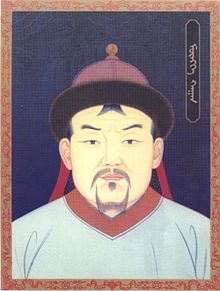 Mongke Khan, Genghis Khan's grandson.
Mongke Khan, Genghis Khan's grandson.
When Mongke's mother Sorghaghtani and their cousin Berke organized a second kurultai on July 1, 1251, the assembled throng proclaimed Mongke Great Khan of the Mongol Empire. This marked a major shift in the leadership of the Empire, transferring power from the descendants of Genghis's son Ogedei to the descendants of Genghis's son Tolui. The decision was acknowledged by a few of the Ogedeid and Chagataid princes, such as Mongke's cousin Kadan and the deposed khan Khara Hulegu, but one of the other legitimate heirs, Ogedei's grandson Shiremun, sought to topple Mongke. Shiremun moved with his own forces towards the emperor's nomadic palace with a covert plan for an armed attack, but Mongke was alerted by his falconer of the plans. Mongke ordered an investigation of the plot, which led to a series of major trials all across the Empire. Many members of the Mongol elite were found guilty and put to death, with estimates ranging from 77-300, though princes of Genghis's royal line were often exiled rather than executed. Mongke eliminated the Ogedeid and the Chagataid families' estates and shared the western part of the Empire with his ally Batu Khan. After the bloody purge, Mongke ordered a general amnesty for prisoners and captives, but ever after, the power of the Great Khan's throne remained firmly with the descendants of Genghis's son Tolui.[55]
Mongke was a serious man who followed the laws of his ancestors and avoided alcoholism. He was tolerant of outside religions and artistic styles, which led to the building of foreign merchants' quarters, Buddhist monasteries, mosques, and Christian churches in the Mongol capital. As construction projects continued, Karakorum was adorned with Chinese, European and Persian architecture. One famous example was a large silver tree with cleverly designed pipes which dispensed various drinks. The tree, topped by a triumphant angel, was crafted by Guillaume Boucher, a Parisian goldsmith.[56]
Although he had a strong Chinese contingent, Mongke relied heavily on Muslim and Mongol administrators, and he launched a series of economic reforms to make government expenses more predictable. His court limited government spending and prohibited nobles and the troops from abusing civilians or issuing edicts without authorization. He commuted the contribution system into a fixed poll tax which was collected by imperial agents and forwarded to needy units. His court also tried to lighten the tax burden on commoners by reducing tax rates. Along with the reform of the tax system, he reinforced the guards at the postal relays and centralized control of monetary affairs. Mongke also ordered an empire-wide census in 1252 which took several years to complete, not being finished until Novgorod in the far northwest was counted in 1258.[57]
In another move to consolidate his power, Mongke assigned his brothers Hulagu and Kublai to rule Persia and Mongol-held China. In the southern part of the Empire, he continued his predecessors' struggle against the Song Dynasty. In order to outflank the Song from three directions, Mongke dispatched Mongol armies under his brother Kublai to Yunnan, and under his uncle Iyeku to subdue Korea and pressure the Song from that direction as well. Kublai conquered the Dali Kingdom in 1253, and Mongke's general Qoridai stabilized his control over Tibet, inducing leading monasteries to submit to Mongol rule. Subotai's son, Uryankhadai, reduced neighboring peoples of Yunnan to submission and beat the Trần Dynasty in northern Vietnam into temporary submission in 1258.[50]
After stabilizing the Empire's finances, Mongke once again sought to expand its borders. At kurultais in Karakorum in 1253 and 1258 he approved new invasions of the Middle East and south China. Mongke put Hulagu in overall charge of military and civil affairs in Persia, and appointed Chagataids and Jochids to join Hulagu's army. The Muslims from Qazvin denounced the menace of the Nizari Ismailis, a heretical sect of Shiites. The Mongol Naiman commander Kitbuqa began to assault several Ismaili fortresses in 1253, before Hulagu deliberately advanced in 1256. Ismaili Grand Master Rukn ud-Din surrendered in 1257 and was executed. All of the Ismaili strongholds in Persia were destroyed by Hulagu's army in 1257 though Girdukh held out until 1271.[58]
 Fall of Baghdad in 1258, an event often considered as the single most catastrophic event in the history of Islam.
Fall of Baghdad in 1258, an event often considered as the single most catastrophic event in the history of Islam.
The center of the Islamic Empire at the time was Baghdad, which had held power for 500 years but was suffering internal divisions. When its caliph al-Mustasim refused to submit to the Mongols, Baghdad was besieged and captured by the Mongols in 1258, an event often considered as the single most catastrophic event in the history of Islam. With the destruction of the Abbasid Caliphate, Hulagu had an open route to Syria and moved against the other Muslim powers in the region. His army advanced towards Ayyubid-ruled Syria, capturing small local states en route.[59][Full citation needed] The sultan Al-Nasir Yusuf of the Ayyubids refused to show himself before Hulagu; however, he had accepted Mongol supremacy two decades earlier. When Hulagu headed further west, the Armenians from Cilicia, the Seljuks from Rum and the Christian realms of Antioch and Tripoli submitted to Mongol authority, joining the Mongols in their assault against the Muslims. While some cities surrendered without resisting, others such as Mayafarriqin fought back; their populations were massacred and the cities were sacked.[60]
Meanwhile, in the northwestern portion of the Empire, Batu's successor and younger brother Berke sent punitive expeditions to the Ukraine, Belarus, Lithuania and Poland. Dissension began brewing between the northwestern and southwestern sections of the Mongol Empire, as Batu suspected that Hulagu's invasion of Western Asia would result in the elimination of Batu's own predominance there.[61]
Disintegration
The Mongol Empire after the death of Mongke Khan (r.1251-59).
Dispute over succession
In the southern part of the Empire, Mongke Khan himself had led his army to complete the conquest of China. Military operations though, while generally successful, were prolonged. The weather became extremely hot and the Mongols began to suffer from bloody epidemics. Mongke decided to stay instead of retiring north as the Mongols usually did, and died there on August 11, 1259. This event began a new chapter of history for the Mongols, as again a decision needed to be made on a new Great Khan, and Mongol armies across the Empire withdrew from their campaigns to once again convene for a new kurultai.[62]
When Mongke's brother Hulagu received the news, he broke off his successful military advance into Syria, and withdrew the bulk of his forces to Mughan, leaving only a small contingent under his general Kitbuqa. The opposing forces in the region, the Christian Crusaders and Muslim Mamluks, then engaged in an unusual passive truce with each other as they both recognized that the Mongols were the greater threat. Taking advantage of the weakened state of the Mongol forces, the Mamluks advanced from Egypt, being allowed to camp and resupply near the Christian stronghold of Acre, and engaged Kitbuqa's forces just north of Galilee, at the Battle of Ain Jalut in 1260. The Mongols were defeated, and Kitbuqa executed. This pivotal battle marked the western limit for Mongol expansion, as the Mongols were never again able to make any serious military advances further than Syria.[63]
In a separate part of the Empire, another brother of Hulagu and Mongke, Kublai, heard of the Great Khan's death at the Huai in China. Rather than returning to the capital though, he continued his advance into the Wuchang area of China, near the Yangtze River. Their younger brother Ariqboke took advantage of the absence of Hulagu and Kublai, and used his position at the capital to win the title of Great Khan for himself. Representatives of all the family branches proclaimed him as the leader at the kurultai in Karakorum. When Kublai learned of this though, he summoned his own kurultai at Kaiping, where virtually all the senior princes and great noyans resident in North China and Manchuria supported his own candidacy over that of Ariqboke.[45]
Civil war
See also: Berke–Hulagu warBattles ensued between the armies of Kublai and those of his brother Ariqboke, which included forces still loyal to Mongke's previous administration. Kublai's army easily eliminated Ariqboke's supporters, and seized control of the civil administration in southern Mongolia. Further challenges took place from their cousins, the Chagataids. Kublai sent Abishka, a Chagataid prince loyal to him, to take charge of Chagatai's realm. But Ariqboke captured and then executed Abishka, having his own man Alghu crowned there instead. Kublai's new administration blockaded Ariqboke in Mongolia to cut off food supplies, causing a famine. Karakorum fell quickly to Kublai, but Ariqboke rallied and re-took the capital in 1261.[64][65][66]
In the southwestern Ilkhanate, Hulagu was loyal to his brother Kublai, but clashes with their cousin Berke, the ruler of the Golden Horde in the northwestern part of the Empire, began in 1262. The suspicious deaths of Jochid princes in Hulagu's service, unequal distribution of war booties and Hulagu's massacres of the Muslims increased the anger of Berke, who considered supporting a rebellion of the Georgian Kingdom against Hulagu's rule in 1259-1260.[67][Full citation needed] Berke also forged an alliance with the Egyptian Mamluks against Hulagu, and supported Kublai's rival claimant, Ariqboke.[68] Hulagu died on February 8, 1264. Berke sought to take advantage of this and invade Hulagu's realm, but died himself along the way, and a few months later, Alghu Khan of the Chagatai Khanate died as well. Kublai named Hulagu's son Abaqa as a new Ilkhan, and Abaqa sought foreign alliances, such as attempting to form a Franco-Mongol alliance with the Europeans against the Egyptian Mamluks. To lead the Golden Horde, Kublai nominated Batu's grandson Mongke Temur.[69] Ariqboqe surrendered to Kublai at Shangdu on August 21, 1264.[70]
 Rabban Bar Sauma, the ambassador of Great Khan Kublai and Ilkhan Arghun, travelled from Dadu in the East, to Rome, Paris and Bordeaux in the West, meeting with the major rulers of the period in 1287-1288.
Rabban Bar Sauma, the ambassador of Great Khan Kublai and Ilkhan Arghun, travelled from Dadu in the East, to Rome, Paris and Bordeaux in the West, meeting with the major rulers of the period in 1287-1288.
In the south, after the fall of Xiangyang in 1273, the Mongols sought the final conquest of the Song Dynasty in South China. In 1271, Kublai renamed the new Mongol regime in China as the Yuan Dynasty, and sought to sinicize his image as Emperor of China in order to win the control of the millions of Chinese. Kublai moved his headquarters to Dadu, the genesis for what later became the modern city of Beijing, although his establishment of a capital there was a controversial move to many Mongols who accused him of being too closely tied to Chinese culture.[71][72] But the Mongols were eventually successful in their campaigns against China, and the Chinese Song imperial family surrendered to the Yuan in 1276, making the Mongols the first non-Chinese people to conquer all of China. Kublai used his base to build a powerful Empire, creating an academy, offices, trade ports and canals, and sponsoring arts and science. Mongol records list 20,166 public schools created during his reign.[73]
Having achieved actual or nominal dominion over much of Eurasia, and having seen his successful conquest of China, Kublai was in a position to look beyond China. However, his costly invasions of Burma, Annam, Sakhalin and Champa secured only the vassal status of those countries. Mongol invasions of Japan (1274 and 1280) and Java (1293) failed.[73]
Nogai and Konchi, the khan of the White Horde, established friendly relations with the Yuan Dynasty and the Ilkhanate. Political disagreement between contending branches of the family over the office of Great Khan continued, but the economic and commercial success of the Mongol Empire continued despite the squabbling.[74][75][76]
Political struggles and Pax Mongolica
Major changes occurred in the Mongol Empire in the late 1200s. Kublai Khan, after having conquered all of China and established the Yuan Dynasty, died in 1294, and was succeeded by Temur Khan, who continued Kublai's policies. The Ilkhanate remained loyal to the Yuan court, but endured its own power struggle, in part because of a dispute with the growing Islamic factions within the southwestern part of the Empire. When Ghazan took the throne of the Ilkhanate in 1295, he formally accepted Islam as his own religion, and this marked a turning point in Mongol history after which Mongol Persia became more and more Islamic. Ghazan also continued to strengthen ties with the Yuan Dynasty in the east. He found it politically useful to advertise the Great Khan's authority there, because the Golden Horde in Russia had long made claims on Georgia. Within four years, Ghazan began sending tributes to the Yuan court and also appealed to other khans to accept Temur Khan as their overlord.[77] As an ally and subordinate of the Yuan Dynasty, the Ilkhanate maintained a friendly relationship with the latter, and there would see an extensive program of cultural and scientific interaction between them in the following decades.[78]
Ghazan's faith may have been Islamic, but he continued his ancestors’ war with the Egyptian Mamluks, and consulted with his old Mongolian advisers in his native tongue. Ghazan defeated the Mamluk army at the Battle of Wadi al-Khazandar, but was only briefly able to occupy Syria in 1299. The Chagatai Khanate, under its de facto ruler Kaidu, was making constant raids on Khorasan, and this distraction interfered with Ghazan's plan to conquer Syria.
Political struggles also existed within the Golden Horde. Kaidu was at war with both the Ilkhans and the Yuan, and struggling for his own influence within the Horde. He sponsored his own candidate Kobeleg against Bayan (r.1299-1304), the Khan of the White Horde. Bayan, after receiving military support from the Mongol court in Russia, requested assistance from both Temur and the Ilkhanate to organize a unified attack against Kaidu's forces. Temur was amenable, and enlarged counterattacks against Kaidu a year later. After a bloody battle with Temur's armies near Zawkhan River in 1301, the old valiant Kaidu died.[79][80]
 The peace of khans of the four uluses, Temür (Yuan), Chapar (Ulus of Ögedei), Toqta (Golden Horde), Öljaitü (Ilkhanate).[81]
The peace of khans of the four uluses, Temür (Yuan), Chapar (Ulus of Ögedei), Toqta (Golden Horde), Öljaitü (Ilkhanate).[81]
In spite of his conflicts with Kaidu and Duwa, Yuan emperor Temur established a tributary relationship with the war-like Shan brothers after his series of military operations against Thailand from 1297 to 1303. This was to mark the end of the southern expansion of the Mongols. Some Mongols sought to decrease internal strife, and unify under Temur. Duwa, leader of the Chagatai Khanate, initiated a peace proposal and persuaded the Ogedeids that "Let we Mongols stop shedding blood of each other. It is better to surrender to Khagan Temur".[82][83] All Khanates approved a peace treaty in 1304 and accepted Temur's supremacy.[84][85][86][87]
New fighting between Duwa and Kaidu's son Chapar broke out shortly afterwards, but with the assistance of Temur, Duwa defeated the Ogedeids. Tokhta of the Golden Horde, also seeking a general peace, sent 20,000 men to buttress the Yuan frontier.[88]
Under the Pax Mongolica, international trade and cultural exchanges flourished between Asia and Europe. Patterns of Yuan royal textiles could be found on the opposite side of the Empire adorning Armenian decorations, trees and vegetables were transplanted across the Empire, and technological innovations spread from Mongol dominions towards the West.[89][90] This period facilitated a wide-scale exchange of material and cultural wealth between peoples and countries. The communications between the Yuan Dynasty in China and Ilkhanate in Persia encouraged the trade and commerce between the east and the west.
After Tokhta's death in 1312, Ozbeg (r.1313-41) seized the throne of the Golden Horde and persecuted non-Muslim Mongols. The Yuan's influence on the Horde was largely reversed and border clashes between Mongol states resumed. Ayurbawda Khan's envoys backed Tokhta's son against Ozbeg. In the Chagatai Khanate, Esen Buqa I (r. 1309-1318) was enthroned as khan after suppressing a sudden rebellion by Ogedei's descendants and driving Chapar into exile. The Yuan and Ilkhanid armies eventually attacked the Chagatai Khanate.
Realizing economic benefits and the Genghisid legacy, Ozbeg reopened friendly relations with the Yuan in 1326, and strengthened ties with the Muslim world as well, building mosques and other elaborate places such as baths.
By the second decade of the 14th century, Mongol invasions had further decreased. In 1323, Abu Said Khan (r. 1316-35) of the Ilkhanate signed a peace treaty with Egypt. At his request, the Yuan court awarded his custodian Chupan the title of commander-in-chief of all Mongol Khanates. But Chupan's reputation could not save his life in 1327.[91] A new civil war erupted in the Yuan Dynasty in 1327-1328, with Chagatai Khan Eljigidey (r.1326-29) supporting Kusala, the Yuan Khagan Khayisan's son, as Great Khan. Kusala was elected Khagan on August 30, 1329. Fearing Chagataid influence on the Yuan, Tugh Temur's (1304–1332) Kypchak commander poisoned him, and took power for himself. In order to be accepted by other khanates as the sovereign of Mongol World, Tugh Temur, who had a good knowledge of the Chinese language and history and was also a creditable poet, calligrapher, and painter, sent Genghisid princes and notable old Mongol generals’ descendants to the Chagatai Khanate, Ilkhan Abu Said and Ozbeg. In response to his emissaries, they all agreed to send tribute each year.[92] Tugh Temur also gave lavish presents and an imperial seal to Eljigidey to mollify his anger. Since the reign of Tugh Temur, the Kypchak and the Alans became even more powerful at the court of the Yuan. Pope John XXII was presented a memorandum from the eastern church describing their Pax Mongolica that "...Khagan is one of the greatest monarchs and all lords of the state, e.g. the king of Almaligh (Chagatai Khanate), emperor Abu Said and Uzbek Khan, are his subjects, saluting his holiness to pay their respects. These 3 monarchs send their overlord leopards, camels, falcons as well as precious jewelries every year. ... They acknowledge him as their absolute supreme lord.".[93]
Fall
With the death of Ilkhan Abu Said Bahatur in 1335, the Mongol rule in Persia fell into political anarchy. A year later his successor was killed by an Oirat governor and the Ilkhanate was divided between the Suldus, the Jalayir, Qasarid Togha Temür (d.1353) and Persian warlords. Using the dissolution, the Georgians had already pushed out the Mongols when Uyghur commander Eretna established an independent state (Ertenids) in Anatolia in 1336. Following the downfall of their Mongol masters, all-time loyal vassal Armenian Kingdom of Cilicia was threatened by the Mamluks more. Alongside the lost of Mongol domain in Persia, Mongol rulers in China and Chagatai Khanate were in a turmoil so deep that it threatened continuation of their power. Much fear arose outside the Mongol court. The Black Death began in the densely inhabited Mongol dominions from 1313 to 1331. This disastrous plague devastated all khanates, cutting off commercial ties and killing off millions. By the end of the 14th century, it may have taken 70-100 million lives in Africa, Asia and Europe.
As the power of the Mongols declined, chaos erupted everywhere. Golden Horde lost all of its western dominions (including modern Belarus and Ukraine) to Poland and Lithuania from 1342 to 1369. Muslim and non-Muslim princes in the Chagatai Khanate warred with each other from 1331-1343. But the Chagatai Khanate disintegrated when non-Genghisid warlords set up their own puppet khans in Mawarannahr and Moghulistan separately. Janibeg Khan (r. 1342-1357) briefly reasserted Jochid dominance over the Chaghataids to restore their former glory. Demanding submission from an offshoot of the Ilkhanate in Azerbaijan, he boasted that "today three uluses are under my control". However, rival families of the Jochids began fighting for the throne of the Golden Horde after the assassination of his successor Berdibek Khan in 1359. The last Yuan ruler Toghan Temur (r. 1333-70) was powerless to regulate those troubles because the empire nearly reached its end. His court's unbacked currency had entered a hyperinflationary spiral and the Han-Chinese people revolted due to the Yuan's late harsh restrictions. King Gongmin of Goryeo pushed Mongolian garrisons back and exterminated the family of Toghan Temur Khan's empress while Tai Situ Changchub Gyaltsen eliminated the Mongol influence in Tibet.[94]
Increasingly isolated from their subjects, the Mongols quickly lost most of China to the Ming rebels in 1368 and fled to their homeland Mongolia. After the overthrow of the Yuan Dynasty, the Golden Horde lost touch with Mongolia and China, while the two main parts of Chagatai Khanate were defeated by Timur (Tamerlane) (1336–1405). The Golden Horde broke into smaller Turkic-hordes that declined steadily in power through four long centuries. Among them, the Khanate's shadow Great Horde survived until 1502, when one of its successors - the Crimean Khanate sacked Sarai. The Yuan remnants, known as Northern Yuan, continued to rule Mongolia until 1635 when the semi-nomadic Manchus defeated them. The Khalkha under the Genghisids and their former subjects-the Oirat Mongols lost their independence to the Qing Dynasty in 1691 and 1755 respectively. The Crimean Khanate was annexed by the Russian Empire in 1783.[95]
Organization
Main article: Society of the Mongol EmpireMilitary setup
Main article: Mongol military tactics and organizationThe Mongol military organization was simple but effective. It was based on an old tradition of the steppe, which was a decimal system known in Iranian cultures since Achaemenid Persia. Later on, the army was built up from squads of ten men each, called an arbat; ten arbats constituted a company of one hundred, called a zuut; ten zuuts made a regiment of one thousand called myanghan and ten myanghans would then constitute a regiment of ten thousand (tumen), equivalent to a modern division.
Unlike other mobile-only warriors, such as the Xiongnu or the Huns, the Mongols were comfortable in the art of the siege. They were careful to recruit artisans and military talents from the cities they conquered, and along with a group of experienced Chinese engineers and bombardier corps, were experts in building trebuchets, Xuanfeng catapults and other machines with which they could lay siege to fortified positions. These were effectively used in the successful European campaigns under General Subutai. These weapons were sometimes built on the spot using available local resources such as nearby trees.
When in battle Mongol forces used an extensively coordinated combination of armed forces. Although they were famous for their horse archers, troops armed with lances were equally skilled and just as essential to their success. Mongol forces also used engineers in battle, siege engines and rockets were used to disrupt enemy formations, enemy forces were confused with smoke whilst smoke was also used to isolate portions of an enemy force while it was destroyed so that allies were prevented from sending aid.
The army's discipline distinguished Mongol soldiers from their peers. Forces under the command of the Mongol Empire were generally trained, organized, and equipped for mobility and speed. To maximize mobility, Mongol soldiers were relatively lightly armored compared to many of the armies they faced. In addition, soldiers of the Mongol army functioned independently of supply lines, considerably speeding up army movement. Skillful use of couriers enabled these armies to maintain contact with each other and with their higher leaders. Discipline was inculcated during a nerge (traditional hunt), as reported by Juvayni. These hunts were distinct from hunts in other cultures which were the equivalent to small unit actions. Mongol forces would spread out on line, surround an entire region then drive all of the game within that area together. The goal was to let none of the animals escape and to slaughter them all.
 Samurai warriors face Mongols, during the Mongol invasions of Japan. From Takezaki Suenaga's Moko Shurai Ekotoba.
Samurai warriors face Mongols, during the Mongol invasions of Japan. From Takezaki Suenaga's Moko Shurai Ekotoba.
All military campaigns were preceded by careful planning, reconnaissance and gathering of sensitive information relating to enemy territories and forces. The success, organization and mobility of the Mongol armies permitted them to fight on several fronts at once. All males aged from 15 to 60 and capable of undergoing rigorous training were eligible for conscription into the army, a source of honor in their tribal warrior tradition.
Another advantage of the Mongols was their ability to traverse large distances even in debilitatingly cold winters; in particular, frozen rivers led them like highways to large urban conurbations on their banks. In addition to siege engineering, the Mongols were also adept at river-work, crossing the river Sajó in spring flood conditions with thirty thousand cavalry in a single night during the battle of Mohi (April, 1241) to defeat the Hungarian king Bela IV. Similarly, in the attack against the Muslim Khwarezmshah, a flotilla of barges was used to prevent escape on the river.
Law and governance
The Mongol Empire was governed by a code of law devised by Genghis, called Yassa, meaning "order" or "decree". A particular canon of this code was that the nobility shared much of the same hardship as the common man. It also imposed severe penalties – e.g., the death penalty was decreed if the mounted soldier following another did not pick up something dropped from the mount in front. On the whole, the tight discipline made the Mongol Empire extremely safe and well-run; European travelers were amazed by the organization and strict discipline of the people within the Mongol Empire.
Under Yassa, chiefs and generals were selected based on merit, religious tolerance was guaranteed, and thievery and vandalizing of civilian property was strictly forbidden.
The empire was governed by a non-democratic parliamentary-style central assembly, called Kurultai, in which the Mongol chiefs met with the Great Khan to discuss domestic and foreign policies.
Genghis also demonstrated a rather liberal and tolerant attitude to the beliefs of others, and never persecuted people on religious grounds. This was associated with their culture and progressive thought (Roger Bacon). Some historian of the XXth century thought that it was a good military strategy, as when he was at war with Sultan Muhammad of Khwarezm, other Islamic leaders did not join the fight against Genghis — it was instead seen as a non-holy war between two individuals.
Throughout the empire, trade routes and an extensive postal system (yam) were created. Many merchants, messengers and travelers from China, the Middle East and Europe used the system. Genghis Khan also created a national seal, encouraged the use of a written alphabet in Mongolia, and exempted teachers, lawyers, and artists from taxes, although taxes were heavy on all other subjects of the empire.
At the same time, any resistance to Mongol rule was met with massive collective punishment. Cities were destroyed and their inhabitants slaughtered if they defied Mongol orders.
Religions
Main article: Religion in the Mongol EmpireMongols were highly tolerant of most religions, and typically sponsored several at the same time. At the time of Genghis Khan, virtually every religion had found converts, from Buddhism to Christianity and Manichaeism to Islam. To avoid strife, Genghis Khan set up an institution that ensured complete religious freedom, though he himself was a shamanist. Under his administration, all religious leaders were exempt from taxation, and from public service.[96] Mongol emperors organized religious debates among clerics with a large audience.
Initially there were few formal places of worship, because of the nomadic lifestyle. However, under Ögedei, several building projects were undertaken in Karakorum. Along with palaces, Ogodei built houses of worship for the Buddhist, Muslim, Christian, and Taoist followers. The dominant religion at that time was Shamanism, Tengriism and Buddhism, although Ogodei's wife was a Mongol Christian.[97] Three of the four principal khanates embraced Islam.[98][99]
Mail system
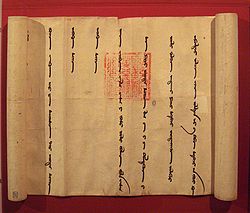 1305 letter (a roll measuring 302 by 50 centimetres (9.91 by 1.6 ft)) from the Ilkhan Mongol Öljaitü to King Philip IV of France.
1305 letter (a roll measuring 302 by 50 centimetres (9.91 by 1.6 ft)) from the Ilkhan Mongol Öljaitü to King Philip IV of France.
The Mongol Empire had an ingenious and efficient mail system for the time, often referred to by scholars as the Yam, which had lavishly furnished and well guarded relay posts known as örtöö set up all over the Mongol Empire. The yam system would be replicated later in the U.S. in the form of the Pony Express.[100] A messenger would typically travel 25 miles (40 km) from one station to the next, and he would either receive a fresh, rested horse or relay the mail to the next rider to ensure the speediest possible delivery. The Mongol riders regularly covered 125 miles (200 km) per day, which is faster than the fastest record set by the Pony Express some 600 years later.
It is said that Genghis and his successor Ogedei built roads. One of roads that Ogedei built carved the Altai Range. After his enthronement, the latter organized the road system and ordered the Chagatai Khanate and Golden Horde to link up roads in western parts of the Mongol Empire.[101] In order to reduce pressure on households, he set up relay stations with attached households every 25 miles (40 km). Although, someone with paiza was allowed to supply with remounts and served specified rations, those carrying military rarities used the Yam even without a paiza. News of the Great Khan's death in Karakorum reached the Mongols forces under Batu Khan in Central Europe within 4–6 weeks thanks to the Yam.[43]
Kublai Khan, the founder of the Yuan Dynasty, built special relays for high officials, as well as ordinary relays which had hostels. During Kublai's reign, the Yuan communication system consisted of some 1,400 postal stations, which used 50,000 horses, 8,400 oxen, 6,700 mules, 4,000 carts, and 6,000 boats.[102] In Manchuria and southern Siberia, the Mongols still used dogsled relays for the yam. In the Ilkhanate, Ghazan restored the declining relay system in the Middle East on a restricted scale. He constructed some hostels and decreed that only imperial envoys could receive a stipend. The Jochids of the Golden Horde financed their relay system by a special jam tax.[Full citation needed]
Silk Road
Main article: Silk RoadSee also: Pax MongolicaThe Mongols had a strong history of supporting merchants and trade. Genghis Khan had encouraged foreign merchants early in his career, even before uniting the Mongols. Merchants provided him with information about neighboring cultures, served as diplomats and official traders for the Mongols, and were essential for many needed goods, since the Mongols produced little of their own. Mongols sometimes provided capital for merchants, and sent them far afield, in an ortoq (merchant partner) arrangement. As the Empire grew, any merchants or ambassadors with proper documentation and authorization, received protection and sanctuary as they traveled through Mongol realms. Well-traveled and relatively well-maintained roads linked lands from the Mediterranean basin to China, and greatly increasing overland trade, and resulting in some dramatic stories of those who traveled what became known as the Silk Road. One of the best known travelers from West to East was Marco Polo, and a comparable journey from East to West was that of the Chinese Mongol monk Rabban Bar Sauma, who traveled from his home of Khanbaliq (Beijing) as far as Europe. European missionaries such as William of Rubruck also traveled to the Mongol court, on missions of conversion, or as papal envoys, carrying correspondence between the Pope and the Mongols as attempts were made to form a Franco-Mongol alliance. It was rare though for anyone to travel the entire length of the Silk Road. Instead, traders moved products much like a bucket brigade, with luxury goods being traded from one middleman to another, from China to the West, and resulting in extravagant prices for the trade goods.
After Genghis, the merchant partner business continued to flourish under his successors Ogedei and Guyuk. Merchants brought clothing, food, and other provisions to the imperial palaces, and in return the Great Khans gave the merchants tax exemptions, and allowed them to use the official relay stations of the Mongol Empire. Merchants also served as tax farmers in China, Russia and Iran. If the merchants were attacked by bandits, losses were made up from the imperial treasury.
Policies changed under the Great Khan Mongke. Because of money laundering and overtaxing, he attempted to limit abuses and sent imperial investigators to supervise the ortoq businesses. He decreed all merchants must pay commercial and property taxes, and he paid off all drafts drawn by high ranking Mongol elites from the merchants. This policy continued in the Yuan Dynasty.
The fall of the Mongol Empire led to the collapse of the political, cultural, and economic unity along the Silk Road. Turkic tribes seized the western end of the Silk Road trade routes from the decaying Byzantine Empire, and sowed the seeds of a Turkic culture that would later crystallize into the Ottoman Empire under the Sunni faith. In the East, the native Chinese overthrew the Yuan Dynasty in 1368, launching their own Ming Dynasty and pursuing a policy of economic isolationism.[103]
Legacy
See also: History of MongoliaThe Mongol Empire had a lasting impact, unifying large regions, some of which (such as eastern and western Russia and the western parts of China) remain unified today, albeit under different rulership. The Mongols, except the main population, might have been assimilated into local populations after the fall of the empire, and some of these descendants adopted local religions — for example, the eastern Khanates largely adopted Buddhism, and the western Khanates adopted Islam, largely under Sufi influence.[104]
According to some interpretretations, Genghis Khan's conquests caused wholesale destruction on an unprecedented scale in certain geographical regions, and therefore led to some changes in the demographics of Asia, such as the mass migration of the Iranian tribes of Central Asia into modern Iran. The Islamic world was also subject to massive changes as a result of Mongol invasions. The population of the Iranian plateau was decimated, resulting in the deaths of up to three-quarters of its population, possibly 10 to 15 million people. Historian Steven Ward estimates that Iran's population did not again reach its pre-Mongol levels until the mid-20th century.[105]
Non-military achievements of the Mongol Empire include the introduction of a writing system, the old Mongol alphabet based on the Uighur characters, designed to write in Mongol language. that is still used today in Inner Mongolia.[106]
 This map shows the boundary of 13th century Mongol Empire compared to today's Mongols in Mongolia, Russia, the Central Asian States and China.
This map shows the boundary of 13th century Mongol Empire compared to today's Mongols in Mongolia, Russia, the Central Asian States and China.
Some of the other long-term consequences of the Mongol Empire include:
- Moscow rose to prominence during the Mongol-Tatar yoke, some time after Russian rulers were accorded the status of tax collectors for the Mongols. The fact that the Russians collected tribute and taxes for the Mongols, meant that the Mongols themselves would rarely visit the lands that they owned. The Russians eventually gained military power, and their ruler Ivan III overthrew the Mongols completely to form the Russian Tsardom, after the Great stand on the Ugra river proved the Mongols vulnerable, and led to the independence of the Grand Duke of Moscow.
- Europe's knowledge of the known world was immensely expanded by the information brought back by ambassadors and merchants. When Columbus sailed in 1492, his missions were to reach Cathay, the land of the Grand Khan in China, and give him a letter from the monarchs Ferdinand II of Aragon and Isabella I of Castile.
- Some research studies indicate that the Black Death which devastated Europe in the late 1340s may have reached from China to Europe along the trade routes of the Mongol Empire. In 1347, the Genoese possession of Caffa, a great trade emporium on the Crimean peninsula, came under siege by an army of Mongol warriors under the command of Janibeg. After a protracted siege during which the Mongol army was reportedly withering from the disease, they decided to use the infected corpses as a biological weapon. The corpses were catapulted over the city walls, infecting the inhabitants.[107] The Genoese traders fled, transferring the plague via their ships into the south of Europe, whence it rapidly spread. The total number of deaths worldwide from the pandemic is estimated at 75 million people, with an estimated 20 million deaths in Europe alone.
- Western researcher R. J. Rummel estimated that 30 million people were killed under the rule of the Mongol Empire. The population of China fell by half in fifty years of Mongol rule. Before the Mongol invasion, the territories of the Chinese dynasties reportedly had approximately 120 million inhabitants; after the conquest was completed in 1279, the 1300 census reported roughly 60 million people. While it is tempting to attribute this major decline solely to Mongol ferocity, scholars today have mixed sentiments regarding this subject. Scholars such as Frederick W. Mote argue that the wide drop in numbers reflects an administrative failure to record rather than a de facto decrease whilst others such as Timothy Brook argue that the Mongols created a system of enserfment among a huge portion of the Chinese populace causing many to disappear from the census altogether. Other historians like William McNeill and David Morgan argue that the Bubonic Plague was the main factor behind the demographic decline during this period
David Nicole states in The Mongol Warlords, "terror and mass extermination of anyone opposing them was a well tested Mongol tactic."[108] About half of the Russian population may have died during the invasion.[109] However, Colin McEvedy (Atlas of World Population History, 1978) estimates the population of Russia-in-Europe dropped from 7.5 million prior to the invasion to 7 million afterwards.[108] Historians estimate that up to half of Hungary's two million population at that time were victims of the Mongol invasion.[110] Rogerius, a monk who survived the Mongol invasion of Hungary, pointed out not only the genocidal element of the occupation, but also that the Mongols especially "found pleasure" in humiliating women.[111]
One of the more successful tactics employed by the Mongols was to wipe out urban populations that had refused to surrender. For example, after the conquest of Urgench, each Mongol warrior – in an army group that might have consisted of two tumens (units of 10,000) – was required to execute 24 people. In the Mongol invasion of Rus, almost all major cities were destroyed. If they chose to submit, the people were spared and treated as slaves, which meant most of them would be driven to die quickly by hard work, with the exception that war prisoners became part of the Mongol army to aid in future conquests.[112] In addition to intimidation tactics, the rapid expansion of the Empire was facilitated by military hardiness (especially during bitterly cold winters), military skill, meritocracy, and discipline. Subutai, in particular among the Mongol Commanders, viewed winter as the best time for war — while less hardy people hid from the elements, the Mongols were able to use frozen lakes and rivers as highways for their horsemen, a strategy he used with great effect in Russia.
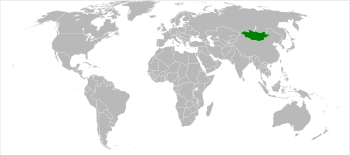 Mongolia today.
Mongolia today.
The influence of the Mongol Empire may prove to be even more direct — Zerjal et al. [2003][113] identify a Y-chromosomal lineage present in about 8% of the men in a large region of Asia (or about 0.5% of the men in the world). The paper suggests that the pattern of variation within the lineage is consistent with a hypothesis that it originated in Mongolia about 1,000 years ago. Such a spread would be too rapid to have occurred by diffusion, and must therefore be the result of selection. The authors propose that the lineage is carried by likely male line descendants of Genghis Khan, and that it has spread through social selection.
In addition to the Khanates and other descendants, the Mughal royal family of South Asia are also descended from Genghis Khan: Babur's mother was a descendant — whereas his father was directly descended from Timur (Tamerlane). The word "Mughal"(مغول) is a Persian word for Mongol.
Notes
- ^ The actual foundation of this city did not occur until 1220, and served as the capital of the Mongol Empire as least until 1259.
- ^ After the death of Möngke Khan in 1259, there was no single major city in the empire, with Dadu being the capital of the Yuan Dynasty from 1272 to 1368.
References
- ^ Finlay, Pilgrim Art, p. 151
- ^ http://www.britannica.com/EBchecked/topic/102315/history-of-Central-Asia/73543/Creation-of-the-Mongol-empire
- ^ «Mongolia se encomienda a Gengis Jan» (en español). diario El País 18.08.2007 (2007). Consultado el 19/06/2008.
- ^ Peter Turchin, Thomas D. Hall and Jonathan M. Adams, "East-West Orientation of Historical Empires", Journal of World-Systems Research Vol. 12 (no. 2), pp. 219-229 (2006).
- ^ Diamond, Guns, Germs, and Steel, p. 367
- ^ The Mongols and Russia, by George Vernadsky
- ^ The Mongol World Empire, 1206-1370, by John Andrew Boyle
- ^ The History of China, by David Curtis Wright, p. 84
- ^ The Early Civilization of China, by Yong Yap Cotterell, Arthur Cotterell, p. 223
- ^ Mongols and Mamluks: The Mamluk-Ilkhanid War, 1260-1281 by Reuven Amitai-Preiss
- ^ Gregory G.Guzman - Were the barbarians a negative or positive factor in ancient and medieval history?, The historian 50 (1988), 568-70
- ^ Thomas T.Allsen - Culture and conquest in Mongol Eurasia, 211
- ^ "The Islamic World to 1600: The Golden Horde". University of Calgary. 1998. http://www.ucalgary.ca/applied_history/tutor/islam/mongols/goldenHorde.html. Retrieved December 3, 2010.
- ^ Michael Biran, Qaidu and the Rise of the Independent Mongol State in Central Asia. The Curzon Press, 1997, ISBN 0-7007-0631-3
- ^ The Cambridge History of China: Alien Regimes and Border States, p413
- ^ Peter Jackson-The Mongols and the West, p.127
- ^ Culture and Conquest in Mongol Eurasia. By THOMAS T. ALLSEN. Cambridge Studies in Islamic Civilization. Cambridge: CAMBRIDGE UNIVERSITY PRESS, 2001. Pp. xiii 235.
- ^ John Joseph Saunders, History of the Mongol conquests, p. 225
- ^ Volker Rybatzki, Igor de Rachewiltz, The early mongols: language, culture and history, p. 116.
- ^ Thomas J. Barfield, The Perilous Frontier, p.184
- ^ a b c d e Morgan, The Mongols, pp. 49–73
- ^ Riasanovsky, Fundamental Principles of Mongol law, p. 83
- ^ Paul Ratchnevsky Genghis Khan: His Life and Legacy, trans. Thomas Nivison Haining, pp. 191
- ^ Secret history, p. 203
- ^ B.Y. Vladimortsov, The life of Chingis Khan, trans. Pricne. D.S. Mirsky, p.74
- ^ Weatherford, p. 70
- ^ Morgan, pp. 99–101
- ^ John Man, Genghis Khan: Life, death and resurrection, p. 288
- ^ a b J.Bor – Mongol hiigeed Eurasiin diplomat shashtir, boti II, p.165
- ^ Atwood, p. 277
- ^ Morris Rossabi, China among equals: the Middle Kingdom and its neighbors, 10th-14th centuries, p. 221
- ^ Atwood, p. 509
- ^ Timothy May, Chormaqan, p.29
- ^ Reuven Amitai Press, The Mamluk-Ilkhanid war
- ^ Mongolia Society, Occasional Papers, p.17
- ^ Timothy May, Chormaqan, p. 32
- ^ Jackson, Delhi Sultanate, p. 105
- ^ Bor, p.186
- ^ Atwood, p. 297
- ^ W.E.Henthorn, Korea, the Mongol invasions
- ^ Weatherford, p. 157
- ^ Howorth, pp. 55-62
- ^ a b Weatherford, p. 158
- ^ Matthew Paris, English history (trans. by J.A.Giles), p. 348
- ^ a b Morgan, p. 104
- ^ Jackson, Mongols and the West, p. 95
- ^ The Academy of Russian science and the academy of Mongolian science-Tataro-Mongols in Europe and Asia, p.89
- ^ Weatherford, p. 163
- ^ John Man, Kublai Khan, p. 28
- ^ a b c Atwood, p. 255
- ^ D.Bayarsaikhan, Ezen khaaniig Ismailiinhan horooson uu (Did the Ismailis kill the Great Khan)
- ^ Weatherford, p. 179
- ^ Atwood, p. 213
- ^ Morgan, The Mongols, p. 159
- ^ Morgan, The Mongols, pp. 103–104
- ^ Guzman, Gregory G. (Spring 2010). "European captives and craftsmen among the Mongols, 1231-1255". The Historian 72 (1): 122–150. doi:10.1111/j.1540-6563.2009.00259.x.
- ^ Thomas T. Allsen, Mongol Imperialism: The Policies of the Grand Qan Möngke in China, Russia, and the Islamic Lands, 1251-1259, p. 280; ISBN 0-520-05527-6
- ^ Morgan, The Mongols, p. 129
- ^ L.N.Gumilev, Black Legend
- ^ Morgan, The Mongols, p. 133
- ^ Morgan, The Mongols, pp. 127–128
- ^ Lane, Daily life in the Mongol Empire, p.9
- ^ Morgan, The Mongols, 2nd ed., p. 138
- ^ Wassaf, p. 12
- ^ Jackson, Mongols and the West, p. 109
- ^ Barthold, Turkestan, p.488
- ^ L.N.Gumilev, A.Kruchki, Black legend
- ^ Barthold, Turkestan down to the Mongol invasion, p. 446
- ^ Prawdin, Mongol Empire and its legacy, p. 302
- ^ Weatherford, p. 120
- ^ John Man, p.74
- ^ Sh.Tseyen-Oidov – Ibid, p.64
- ^ a b John Man, Kublai Khan, p. 207
- ^ Weatherford, p. 195
- ^ Vernadsky, The Mongols and Russia, pp. 344-366
- ^ Henryk Samsonowicz, Maria Bogucka, A Republic of Nobles, p. 179
- ^ Michael Prawdin (Carol), The Mongol Empire: Its rise and legacy
- ^ Allsen, Culture and conquest in Mongol Eurasia, pp. 32-35
- ^ Rene Grousset, The Empire of the Steppes
- ^ Atwood, p. 445
- ^ Bibliothèque nationale de France. Département des Manuscrits. Division occidentale. Nouvelle acquisition française 886, fol. 37v
- ^ d.Ohson, History of the Mongols, p.II, p. 355
- ^ Sh.Tseyen-Oidov, Genghis bogdoos Ligden khutagt khurtel (khaad), p. 81
- ^ Vernadsky – The Mongols and Russia, p. 74
- ^ Oljeitu's letter to Philipp the Fair
- ^ J.J.Saunders – The History of the Mongol conquests
- ^ Howorth, p. 145
- ^ Atwood, p. 106
- ^ Weatherford, p. 236
- ^ Dickran Kouymjian – Chinese motifs in the 13th century Armenian art: The Mongol connection, p.303
- ^ Thomas T. Allsen, Culture and Conquest in Mongol Eurasia, p. 39
- ^ Herbert Franke, Denis Twitchett, Alien Regimes and Border States, 907-1368 pp. 541-550
- ^ G.V.Vernadsky, The Mongols and Russia, p.93
- ^ Michael Prawdin, The Mongol Empire and its legacy, p. 379
- ^ Charles J. Halperin, Russia and the Golden Horde: The Mongol Impact on Medieval Russian History, p. 28
- ^ Weatherford, p. 69
- ^ Weatherford, p. 135
- ^ Ezzati, The spread of Islam: the contributing factors, p. 274
- ^ Bukharaev, Islam in Russia: the four seasons, p. 145
- ^ Chambers, James, The Devil's Horsemen Atheneum, 1979, ISBN 0-689-10942-3
- ^ Secret history of the Mongols
- ^ The new history of Yuan Dynasty, Beijing 1998
- ^ Guoli Liu-Chinese foreign policy in transition, p.364]
- ^ Foltz, pp. 105–106
- ^ R. Ward, Steven (2009). Immortal: a military history of Iran and its armed forces. Georgetown University Press. p. 39. ISBN 1589012585. http://books.google.com/books?id=8eUTLaaVOOQC&pg=PA39&dq#v=onepage&q=&f=false.
- ^ Hahn, Reinhard F. (1991), Spoken Uyghur, London and Seattle: University of Washington Press, ISBN 978-0-295986-51-7
- ^ Svat Soucek. A History of Inner Asia. Cambridge University Press, 2000. ISBN 0-521-65704-0. P. 116.
- ^ a b Mongol Conquests
- ^ History of Russia, Early Slavs history, Kievan Rus, Mongol invasion
- ^ The Mongol invasion: the last Arpad kings
- ^ "Life after death: approaches to a cultural and social history of Europe during the 1940s and 1950s". Richard Bessel, Dirk Schumann (2003). Cambridge University Press. p.143. ISBN 978-0-521-00922-5
- ^ The Story of the Mongols Whom We Call the Tartars= Historia Mongalorum Quo s Nos Tartaros Appellamus: Friar Giovanni Di Plano Carpini's Account of His Embassy to the Court of the Mongol Khan by Da Pian Del Carpine Giovanni and Erik Hildinger (Branden BooksApril 1996 ISBN 978-0-8283-2017-7)
- ^ Zerjal, Xue, Bertolle, Wells, Bao, Zhu, Qamar, Ayub, Mohyuddin, Fu, Li, Yuldasheva, Ruzibakiev, Xu, Shu, Du, Yang, Hurles, Robinson, Gerelsaikhan, Dashnyam, Mehdi, Tyler-Smith (2003). "The Genetic Legacy of the Mongols". American Journal of Human Genetics (72): 717–721.
Sources
- Allsen, Thomas T. (2004). Culture and conquest in Mongol Eurasia. Cambridge, UK: Cambridge University Press. ISBN 9780521602709.
- Amitai-Preiss, Reuven (1995). Mongols and Mamluks: The Mamluk-Ilkhanid War, 1260–1281. Cambridge, UK; New York, New York, USA: Cambridge University Press. ISBN 9780521462266.
- Atwood, Christopher P. (2004). Encyclopedia of Mongolia and the Mongol Empire. New York, New York, USA: Facts on File, Inc.. ISBN 0-8160-4671-9.
- Diamond, Jared (1997). Guns, Germs, and Steel: The Fates of Human Societies. W.W. Norton & Co.. ISBN 0-393-06131-0.
- Finlay, Robert (2010). The Pilgrim Art: Cultures of Porcelain in World History. Berkeley: University of California Press. ISBN 9780520244689.
- Foltz, Richard C. (1999). Religions of the Silk Road: Overland Trade and Cultural Exchange from Antiquity to the Fifteenth Century. New York, New York, USA: St. Martin's Press. ISBN 0-312-23338-8.
- Grousset, Rene (1970). The Empire of the Steppes: a History of Central Asia.. Translated from French by Naomi Walford. New Brunswick, NJ: Rutgers University Press.
- Howorth, Henry H. History of the Mongols from the 9th to the 19th Century: Part I: The Mongols Proper and the Kalmuks. New York: Burt Frankin, 1965 (reprint of London edition, 1876).
- Jackson, Peter (2003). The Delhi Sultanate: A Political and Military History. Cambridge, UK; New York, New York, USA: Cambridge University Press. ISBN 0521543290.
- Jackson, Peter (1978). "The dissolution of the Mongol Empire". CAJ XXXII: 208–351.
- Jackson, Peter (2005). The Mongols and the West: 1221-1410. Harlow, UK; New York, New York, USA: Longman. ISBN 978-0582368965.
- Lane, George (2006). Daily life in the Mongol empire. Greenwood Press. ISBN 9780313332265.
- Morgan, David (June 1989). Arbel, B.; et al.. ed. "The Mongols and the Eastern Mediterranean: Latins and Greeks in the Eastern Mediterranean after 1204". Mediterranean Historical Review (Tel Aviv, Illinois: Routledge) 4 (1): 204. doi:10.1080/09518968908569567. ISSN 0951-8967.
- Morgan, David (2007). The Mongols (2nd ed.). Malden, Massachusetts, USA; Oxford, UK; Carlton, Victoria, AU: Blackwell Publishing. ISBN 9781405135399.
- Prawdin, Michael (pseudonym for Charol, Michael) (1940/1961). Mongol Empire. New Brunswick, New Jersey: Collier-Macmillan Canada. ISBN 1412805198.
- Weatherford, Jack (2004). Genghis Khan and the Making of the Modern World. Three Rivers Press. ISBN 0-609-80964-4.
Further reading
- Brent, Peter. The Mongol Empire: Genghis Khan: His Triumph and his Legacy. Book Club Associates, London. 1976.
- Buell, Paul D. (2003), Historical Dictionary of the Mongol World Empire, The Scarecrow Press, Inc., ISBN 0-8108-4571-7
- Kradin, Nikolay, Tatiana Skrynnikova. "Genghis Khan Empire". Moscow: Vostochnaia literatura, 2006. 557 p. (ISBN 5-02-018521-3).
- Kradin, Nikolay, Tatiana Skrynnikova. "Why do we call Chinggis Khan's Polity 'an Empire' ". Ab Imperio, Vol. 7, No 1(2006): 89-118. (ISBN 5-89423-110-8)
- May, Timothy. "The Mongol Art of War." Westholme Publishing, Yardley. 2007. ISBN 978-1-59416-046-2 / ISBN 1-59416-046-5
- Woods, Shelton (2002). Vietnam: An Illustrated History. Hippocrene Books Inc. ISBN 0-7818-0910-X
- (French) Dominique Farale, De Gengis Khan à Qoubilaï Khan : la grande chevauchée mongole, Economica, 2003 (ISBN 2-7178-4537-2)
- (French) Dominique Farale, La Russie et les Turco-Mongols: 15 siècles de guerre, Economica, 2007. ISBN 978-2-7178-5429-9
External links
- Genghis Khan and the Mongols
- The Mongol Empire
- Mongols
- Genghis Khan Biography
- The Mongols in World History
- The Mongol Empire for students
- Paradoxplace Insight Pages on the Mongol Emperors
- William of Rubruck's Account of the Mongols
- Mongol invasion of Rus (pictures)
- Worldwide Death Toll
- Mongol Empire Google Earth
A history of empires Ancient empires Medieval empires Byzantine · Hunnic · Arab (Rashidun · Umayyad · Abbasid · Fatimid · Caliphate of Córdoba · Ayyubid) · Moroccan (Idrisid · Almoravid · Almohad · Marinid) · Persian (Tahirid · Samanid · Buyid · Sallarid · Ziyarid) · Ghaznavid · Bulgarian (First · Second) · Benin · Great Seljuq · Oyo · Bornu · Khwarezmian · Aragonese · Timurid · Indian (Chola · Gurjara-Pratihara · Pala · Eastern Ganga dynasty · Delhi) · Mongol (Yuan · Golden Horde · Chagatai Khanate · Ilkhanate) · Kanem · Serbian · Songhai · Khmer · Carolingian · Holy Roman · Angevin · Mali · Chinese (Sui · Tang · Song · Yuan) · Wagadou · Aztec · Inca · Srivijaya · Majapahit · Ethiopian (Zagwe · Solomonic) · Somali (Ajuuraan · Warsangali) · AdaliteModern empires Tongan · Indian (Maratha · Sikh · Mughal) · Chinese (Ming · Qing) · Ottoman · Persian (Safavid · Afsharid · Zand · Qajar · Pahlavi) · Moroccan (Saadi · Alaouite) · Ethiopian · Somali (Dervish · Gobroon · Hobyo) · French (First · Second) · Austrian (Austro-Hungarian) · German · Russian · Swedish · Mexican (First · Second) · Brazil · Korea · Japan · Haitian (First · Second) · Central AfricanColonial empires Categories:- Former countries in Europe
- Former countries in Asia
- Former empires
- States and territories established in 1206
- States and territories disestablished in 1368
- 1368 disestablishments
- Eurasian nomads
- Horse archer civilizations and empires
- Mongol Empire
- Former monarchies of Asia
- History of Mongolia
- History of Central Asia
- 1206 establishments
Wikimedia Foundation. 2010.



